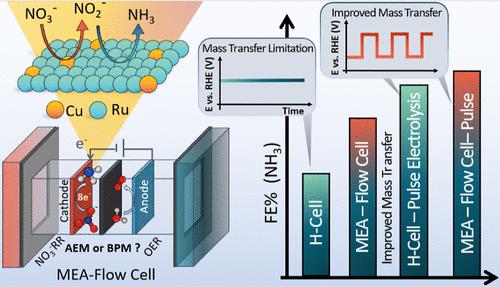Pulsed Electrolysis in Membrane Electrode Assembly Architecture for Enhanced Electrochemical Nitrate Reduction Reaction to Ammonia
IF 11.3
1区 化学
Q1 CHEMISTRY, PHYSICAL
引用次数: 0
Abstract
Electrochemical nitrate reduction reaction (NO3–RR) to ammonia offers a promising solution to environmental and energy challenges, converting a ubiquitous pollutant in aquatic environments into a carbon-free energy carrier and essential chemical feedstock. While considerable research has focused on electrocatalyst development, relatively less attention has been given to device engineering and electroanalytical techniques that play crucial roles in enhancing the performance of the electrocatalytic NO3–RR, especially at such low concentrations. Here, CuxRuy alloy catalysts were synthesized, and their electrocatalytic performance was investigated by using various electroanalytical techniques in H-type and membrane-electrode-assembly (MEA) configurations. The results revealed the poor performance of the electrocatalytic NO3–RR at low NO3– concentrations (0.01 M) in H cells due to the mass transfer loss, promoting the competing hydrogen evolution reaction. Pulsed electrolysis was leveraged as an effective strategy to enhance ammonia yield rate (3-fold) and Faradaic efficiency (FE) (2-fold) compared to the potentiostatic (i.e., constant voltage) condition at low nitrate concentrations, primarily by impacting the local microenvironment. Additionally, an MEA cell was constructed with anionic and bipolar membranes, and a comparative study was conducted by examining cell voltage, selectivity, and energy efficiency. The findings exhibited that membrane type significantly influences cell voltage and system efficiency. Notably, the CuRu alloy catalyst in an MEA system with an anion exchange membrane achieved a FE exceeding 90% at 200 mA cm–2 with the highest NH3 yield rate of 5.74 ± 0.27 mmol h–1 cm–2 and stability over 100 h assessed at 600 mA cm–2. The insights gained from this work could inform the rational design of the electrochemical NO3–RR to ammonia with enhanced catalytic performance at low nitrate concentrations.

膜电极组件结构中的脉冲电解用于增强硝酸盐还原成氨的电化学反应
电化学硝酸盐还原反应(NO3-RR)生成氨为应对环境和能源挑战提供了一个前景广阔的解决方案,它将水生环境中无处不在的污染物转化为一种无碳能源载体和重要的化学原料。虽然大量研究都集中在电催化剂的开发上,但对装置工程和电分析技术的关注相对较少,而这些技术在提高电催化 NO3-RR 的性能方面发挥着至关重要的作用,尤其是在如此低的浓度下。本文合成了 CuxRuy 合金催化剂,并在 H 型和膜电极组装(MEA)结构中使用各种电分析技术研究了它们的电催化性能。结果表明,在 H 型电池中,当 NO3- 浓度较低(0.01 M)时,由于传质损失,电催化 NO3-RR 的性能较差,从而促进了竞争性的氢进化反应。与静电电位(即恒压)条件相比,在低硝酸盐浓度下,脉冲电解是提高氨产量(3 倍)和法拉第效率(FE)(2 倍)的有效策略,这主要是通过影响局部微环境实现的。此外,还用阴离子膜和双极性膜构建了 MEA 电池,并通过检查电池电压、选择性和能效进行了比较研究。研究结果表明,膜类型对电池电压和系统效率有重大影响。值得注意的是,带有阴离子交换膜的 MEA 系统中的 CuRu 合金催化剂在 200 mA cm-2 下的 FE 超过了 90%,NH3 产率最高,达到 5.74 ± 0.27 mmol h-1 cm-2,在 600 mA cm-2 下的稳定性超过 100 小时。从这项工作中获得的启示可为合理设计电化学 NO3-RR 转化氨提供参考,从而提高低硝酸盐浓度下的催化性能。
本文章由计算机程序翻译,如有差异,请以英文原文为准。
求助全文
约1分钟内获得全文
求助全文
来源期刊

ACS Catalysis
CHEMISTRY, PHYSICAL-
CiteScore
20.80
自引率
6.20%
发文量
1253
审稿时长
1.5 months
期刊介绍:
ACS Catalysis is an esteemed journal that publishes original research in the fields of heterogeneous catalysis, molecular catalysis, and biocatalysis. It offers broad coverage across diverse areas such as life sciences, organometallics and synthesis, photochemistry and electrochemistry, drug discovery and synthesis, materials science, environmental protection, polymer discovery and synthesis, and energy and fuels.
The scope of the journal is to showcase innovative work in various aspects of catalysis. This includes new reactions and novel synthetic approaches utilizing known catalysts, the discovery or modification of new catalysts, elucidation of catalytic mechanisms through cutting-edge investigations, practical enhancements of existing processes, as well as conceptual advances in the field. Contributions to ACS Catalysis can encompass both experimental and theoretical research focused on catalytic molecules, macromolecules, and materials that exhibit catalytic turnover.
 求助内容:
求助内容: 应助结果提醒方式:
应助结果提醒方式:


